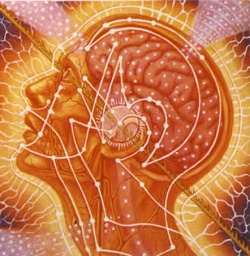Eight Consciousnesses
The Eight Consciousnesses is a classification developed in the tradition of the Yogacara school of Buddhism. They enumerate the five senses, supplemented by the Mind, the "obscuration" of the Mind (Manas), and finally the fundamental store-house Consciousness, which is the basis of the other seven.
Etymology
The Sanskrit term for the Eight Consciousnesses is Aṣṭavijñāna, from aṣṭa "eight" and Vijñāna "Consciousness". The Tibetan term is rnam-shes tshogs-brgyad)
The Sanskrit term for store-house Consciousness is ālayavijñāna, from ālaya "abode, dwelling"; Tibetan: kun gzhi rnam shes; Chinese: 阿賴耶識, Japanese: arayashiki (阿頼耶識)
The Eight Consciousnesses (Aṣṭa Vijñāna)
All Eight Consciousness are "Aggregates" or Skandha.
The first six are the sensate "consciousnesses" plus the Mind. The Yogacara School that espoused the Cittamatra Doctrine proffer two more consciousnesses:
- Eye-consciousnes (Tibetan: mig-gi rnam-shes), seeing apprehended by the visual sense organs;
- Ear-Consciousness (Tibetan: rna’i rnam-shes), hearing apprehended by the auditory sense organs;
- Nose-Consciousness (Tibetan: sna’i rnam-shes), smelling apprehended through the olfactory organs;
- Tongue-Consciousness (Tibetan: lce’i rnam-shes), tasting perceived through the gustatory organs;
- Body-Consciousness (Tibetan: lus-kyi rnam-shes), tactile Feeling apprehended through skin contact, touch.
- \Ideation-consciousnes 意識 (Tibetan: yid-kyi rnam-shes), the aspect of Mind known in Sanskrit as Citta or manovijñāna, the "Mind monkey"; the Consciousness of ideation.
- Manas Consciousness (Sanskrit: klistamanas = klesha; Tibetan: nyon-yid rnam-shes), obscuration-Consciousness ("obscuration", "poison", "enemy"; Manas "ideation", "moving mind", "Mind monkey"), the Consciousness which through apprehension, gathers the hindrances, the poisons, the karmic formations;
- "Store-house Consciousness" 藏識(Sanskrit: alayavijñāna; Tibetan: kun-gzhi rnam-shes), The seed Consciousness 種子識(bi^ja-vijn~a^na), "the Consciousness which is the basis of the other seven" 本識. It is the Aggregate which administers and yields Rebirth.
The eightfold network of primary consciousnesses
All surviving schools of buddhist thought accept – "in common" – the existence of the first six primary consciousnesses (Sanskrit: vijñāna, Tibetan: རྣམ་ཤེས་, Wylie: rnam-shes). The internally coherent Yogācāra school associated with Maitreya, Asaṅga, and Vasubandhu, however, uniquely – or "uncommonly" – also posits the existence of two additional primary consciousnesses, kliṣṭamanas and ālayavijñāna, in order to explain the workings of karma. The first six of these primary consciousnesses comprise the five sensory faculties together with mental consciousness, which is counted as the sixth. According to Gareth Sparham,
- The ālaya-vijñāna doctrine arose on the Indian subcontinent about one thousand years before Tsongkhapa. It gained its place in a distinctly Yogācāra system over a period of some three hundred years stretching from 100 to 400 C.E., culminating in the Mahāyāna-saṁgraha, a short text by Asaṅga (circa 350), setting out a systematic presentation of the ālaya-vijñāna doctrine developed over the previous centuries. It is the doctrine found in this text in particular that Tsongkhapa, in his Ocean of Eloquence, treats as having been revealed in toto by the Buddha and transmitted to suffering humanity through the Yogācāra founding saints (Tib. shing rta srol byed): Maitreya-nātha, Asaṅga, and Vasubandhu.
While some noteworthy modern scholars of the Gelug tradition (which was originally founded by Tsongkhapa's reforms to Atisha's Kadam school) assert that the ālayavijñāna is posited only in the Cittamatra philosophical tenet system, all non-Gelug schools of Tibetan Buddhism maintain that the ālayavijñāna is accepted by the various Madhyamaka schools, as well. The Yogācāra eightfold network of primary consciousnesses – aṣṭavijñāna in Sanskrit (from compounding aṣṭa, "eight", with vijñāna, "primary consciousness"), or Tibetan: རྣམ་ཤེས་ཚོགས་བརྒྱད་, Wylie: rnam-shes tshogs-brgyad – is roughly sketched out in the following table.
| Subgroups | Name of Consciousness | Associated Nonstatic Phœnomena in terms of Three Circles of Action | |||||
| English | Sanskrit | Tibetan | Chinese | Physical Form | Type of Cognition | Cognitive Sensor | |
| I. – VI.
Each of these Six Common Consciousnesses' – referred to in Sanskrit as pravṛtti-vijñāna – are posited on the basis of valid straightforward cognition, on any individual practitioner's part, of sensory data input experienced solely by means of their bodily sense faculties. The derivation of this particular dual classification schema for these first six, so-called "common" consciousnesses has its origins in the first four Nikāyas of the Sutta Pitaka – the second division of the Tipitaka in the Pali Canon – as first committed to writing during the Theravada school's fourth council at Sri Lanka in 83 (BCE). Both individually and collectively: these first six, so-called "common consciousnesses are posited – in common – by all surviving buddhist tenet systems. | |||||||
| I. | cakṣur-vijñāna | ༡
Tibetan: མིག་གི་རྣམ་ཤེས་, Wylie: mig-gi rnam-shes |
眼識 | Sight(s) | Seeing | Eyes | |
| II. | śrotra-vijñāna | ༢
Tibetan: རྣའི་རྣམ་ཤེས་, Wylie: rna’i rnam-shes |
耳識 | Sound(s) | Hearing | Ears | |
| III. | ༣
Tibetan: སྣའི་རྣམ་ཤེས་, Wylie: sna’i rnam-shes |
鼻識 | Smell(s) | Smell | Nose | ||
| IV. | ༤
Tibetan: ལྕེའི་རྣམ་ཤེས་, Wylie: lce’i rnam-shes |
舌識 | Taste(s) | Taste | Tongue | ||
| V. | ༥
Tibetan: ལུས་ཀྱི་རྣམ་ཤེས་, Wylie: lus-kyi rnam-shes |
身識 | Feeling(s) | Touch | Body | ||
| VI. | mano-vijñāna | ༦
Tibetan: ཡིད་ཀྱི་རྣམ་ཤེས་, Wylie: yid-kyi rnam-shes |
意識 | Thought(s) | Ideation | Mind | |
| VII.
This Seventh Consciousness, posited on the basis of straightforward cognition in combination with inferential cognition, is asserted, uncommonly, in Yogācāra. |
VII. | Manas (early Buddhism)Manas, kliṣṭa-manas | ༧
Tibetan: ཉོན་ཡིད་རྣམ་ཤེས་, Wylie: nyon-yid rnam-shes |
末那識 | Self-grasping | Disturbing emotion or attitude (Skt.: klesha) | Mind |
| VIII.
This Eighth Consciousness, posited on the basis of inferential cognition, is asserted, uncommonly, in Yogācāra. |
VIII.
All-encompassing foundation consciousness |
ālāya-vijñāna, bīja-vijñāna | ༨
Tibetan: ཀུན་གཞི་རྣམ་ཤེས་, Wylie: kun-gzhi rnam-shes |
藏識, | Memory | Reflexive awareness | Mind |
Origins and development
Pali Canon
The first five sense-consciousnesses along with the sixth Consciousness are identified in the Sutta Pitaka, especially the Salayatana Vagga subsection of the Samyutta Nikaya:
- "As you say, Lord," the Monks responded.
- The Blessed One said, "What is the All? Simply the Eye & forms, ear & sounds, nose & aromas, tongue & flavors, Body & tactile sensations, intellect & ideas. This, Monks, is called the All. Anyone who would say, 'Repudiating this All, I will describe another,' if questioned on what exactly might be the grounds for his statement, would be unable to explain, and furthermore, would be put to Grief. Why? Because it lies beyond range."
Yogacara
- See also: Yogacara
The Yogacara-school gives a detailed explanation of the workings of the Mind and the way it constructs the reality we experience. It is "meant to be an explanation of experience, rather than a system of ontology". Vasubandhu is considered to be the sytematizer of Yogacara-Thought. Vasubandhu used the concept of the six consciousnesses, on which he elaborated in the Triṃśikaikā-kārikā (Treatise in Thirty Stanzas).
Consciousness
According to the traditional interpretation, Vasubandhu states that there are eight consciousnesses:
- Five sense-consciousnesses,
- Mind (Perception),
- Manas (self-Consciousness),
- Storehouse-Consciousness.
According to Kalupahana, this classification of eight consciousnesses is based on a misunderstanding of Vasubandhu's Triṃśikaikā-kārikā by later adherents.
Aālayavijñāna
The ālaya-Vijñāna forms the "base-Consciousness" (Mūla-Vijñāna) or "causal Consciousness". According to the traditional interpretation, the other seven consciousnesses are "evolving" or "transforming" consciousnesses originating in this base-Consciousness.
The store-house Consciousness accumulates all potential energy for the Mental (nama) and physical (rupa) manifestation of one's existence (namarupa). It is the storehouse-Consciousness which induces transmigration or Rebirth, causing the origination of a new existence.
Rebirth and Purification
The store-house Consciousness receives impressions from all functions of the other consciousnesses, and retains them as potential energy, Bija or "seeds", for their further manifestations and activities. Since it serves as the container for all experiential impressions it is also called the "seed Consciousness" (種子識) or container Consciousness.
According to Yogacara teachings, the seeds stored in the store Consciousness of Sentient beings are not pure.
The store Consciousness, while being originally immaculate in itself, contains a "Mysterious mixture of purity and defilement, Good and Evil". Because of this mixture the transformation of Consciousness from defilement to purity can take place and Awakening is possible.
Through the process of Purification the Dharma practitioner can became an Arahat, when the four Defilements of the Mental functions of the Manas-Consciousness are purified.
Tathagata-garbha Thought
According to The Lankavatara Sutra and the schools of Chan/Zen Buddhism, the Alaya-vjnana is identical with the Tathagata-garbha, and is fundamentally pure.
The equation of Alaya-vjnana and Tathagatagarbha was contested. It was seen as "something akin to the Hindu notions of ātman (permanent, invariant self) and prakṛti (primordial substrative nature from which all Mental, emotional and physical things evolve). The critique led by the end of the eighth century to the rise of ...
- [T]he logico-epistemic tradition of Yogācāra and [...] a hybrid school that combined basic Yogācāra doctrines with Tathāgatagarbha Thought.
- The logico-epistemological wing in part sidestepped the critique by using the term Citta-santāna, "Mind-stream", instead of ālaya-Vijñāna, for what amounted to roughly the same idea. It was easier to deny that a "stream" represented a reified self.
- On the other hand, the Tathāgatagarbha hybrid school was no stranger to the charge of smuggling notions of selfhood into its doctrines, since, for example, it explicitly defined the Tathāgatagarbha as "permanent, pleasurable, self, and pure (nitya, Sukha, ātman, śuddha). Many Tathāgatagarbha texts, in fact, argue for the acceptance of selfhood (ātman) as a sign of higher accomplishment. The hybrid school attempted to conflate Tathāgatagarbha with the ālaya-Vijñāna.
Transformations of Consciousness
The traditional interpretation of the eight consciousnesses may be discarded on the ground of a reinterpretation of Vasubandhu's works.
According to scholar Roger R. Jackson, a "'fundamental unconstructed awareness' (Mūl-nirvikalpa-jñāna)" is "described [...] frequently in Yogacara literature.", Vasubandhu's work
According to Kalupahana, instead of positing additional consciousnesses, the Triṃśikaikā-kārikā describes the transformations of this Consciousness:
- Taking Vipaka, manana and vijnapti as three different kinds of functions, rather than caharacteristics, and understanding Vijnana itself as a function (vijnanatiti vijnanam), Vasubandhu seems to be avoiding any Form of substantialist Thinking in relation to Consciousness.
These transformations are threefold:
- Whatever, indeed, is the variety of ideas of self and elements that prevails, it occurs in the transformation of Consciousness. Such transformation is threefold,
The first transformation results in the Alaya:
- the resultant, what is called mentation, as well as the concept of the object. Herein, the Consciousness called Alaya, with all its seeds, is the resultant.
The Alaya-vijnana therefore is not an eight Consciousness, but the resultant of the transformation of Consciousness:
- Instead of being a completely distinct category, Alaya-vijnana merely represents the normal flow of the stream of Consciousness uninterrupted by the appearance of reflective self-awareness. It is no more than the unbroken stream of Consciousness called the Life-proces by The Buddha. It is the cognitive process, containing both emotive and co-native aspects of human experience, but without the enlarged egoistic ermotions and dogmatic graspings characteristic of the next two transformations.
The second transformation is manana, self-Consciousness or "Self-view, self-confusion, self-esteem and self-Love". According to the Lankavatara and later interpreters it is the seventh Consciousness. It is "Thinking" about the various perceptions occurring in the stream of Consciousness". The Alaya is defiled by this self-Interest;
- [I]t can be purified by adopting a non-substantialist (Anatman) perspective and thereby allowing the Alaya-part (i.e. Attachment) to dissipate, leaving Consciousness or the function of being intact.
The third transformation is visaya-vijnapti, the "concept of the object". In this transformation the concept of objects is created. By creating these concepts human beings become "susceptible to grasping after the object":
- Vasubandhu is critical of the third transformation, not because it relates to the conception of an object, but because it generates grasping after a "real object" (sad artha), even when it is no more than a conception (vijnapti) that combines experience and reflection.
A similar perspective is give by Walpola Rahula. According to Walpola Rahula, all the elements of the Yogācāra storehouse-Consciousness are already found in the Pāli Canon. He writes that the three layers of the Mind (Citta, Manas, and Vijñana) as presented by Asaṅga are also mentioned in the Pāli Canon:
- Thus we can see that 'Vijñāna' represents the simple reaction or response of the sense organs when they come in contact with external objects. This is the uppermost or superficial aspect or layer of the 'Vijñāna-Skandha'. 'Manas' represents the aspect of its Mental functioning, Thinking, reasoning, conceiving ideas, etc. 'Citta' which is here called 'Ālayavijñāna', represents the deepest, finest and subtlest aspect or layer of the Aggregate of Consciousness. It contains all the traces or impressions of the past actions and all Good and bad future possibilities.
Understanding in Buddhist tradition
China
Fa Hsiang and Hua Yen
Although Vasubandhu had postulated numerous ālaya-Vijñāna-s, a separate one for each individual person in the para-kalpita, this multiplicity was later eliminated in the Fa Hsiang and Hua Yen metaphysics. These schools inculcated instead the Doctrine of a single universal and eternal ālaya-Vijñāna. This exalted enstatement of the ālaya-Vijñāna is described in the Fa Hsiang as "primordial unity".
The presentation of the three natures by Vasubandhu is consistent with the Neo-platonist views of Plotinus and his universal 'One', 'Mind', and 'Soul'.
Chán
A core teaching of Chan/Zen Buddhism describes the transformation of the Eight Consciousnesses into the Four Wisdoms. In this teaching, Buddhist practice is to turn the Light of awareness around, from misconceptions regarding the nature of reality as being external, to directly see one's own nature. Thus the Eighth Consciousness is transformed into the Great Perfect Mirror Wisdom, the Seventh Consciousness into the Equality (Universal Nature) Wisdom, the Sixth Consciousness into the Profound Observing Wisdom, and First to Fifth Consciousnesses into the All Performing (Perfection of Action) Wisdom.
Korea
The Interpenetration (通達) and Essence-Function (體用) of Wonhyo (元曉) is described in the Treatise on Awakening Mahāyāna Faith (AMF):
- The author of the AMF was deeply concerned with the question of the respective origins of Ignorance and Enlightenment. If Enlightenment is originally existent, how do we become submerged in Ignorance? If Ignorance is originally existent, how is it possible to overcome it? And finally, at the most basic level of Mind, the Alaya Consciousness (藏識), is there originally purity or taint? The AMF dealt with these questions in a systematic and thorough fashion, working through the Yogacāra concept of the Alaya Consciousness. The technical term used in the AMF which functions as a metaphorical synonym for interpenetration is "permeation" or "perfumation (薫)," referring to the fact that defilement (煩惱) "perfumates" suchness (眞如), and suchness perfumates defilement, depending on the current condition of the Mind.





